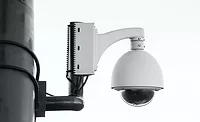3 innovations changing the possibilities of security technology

The security sector is long overdue for innovation. A new era of technology promises to make physical spaces safer than ever from threats both criminal and biological. That same technology also has the potential to make security management more efficient than before. There are compelling reasons to do things differently.
What, specifically? Here are three innovations that are changing the future of security technology:
Artificial intelligence
Surveillance still requires lots of human monitors, but automation and artificial intelligence could change that. These tools are now smart enough to identify anomalies that require someone’s attention, like a car driving into a no-vehicle zone or a courier leaving a package. Events like these can trigger an alert that gets security staff involved only when it’s necessary. Automated surveillance has been around for a while, but it was plagued by false alarms in the past. Recent improvements make it much more intelligent at identifying objects and discerning true threats.
Facial recognition software
Access control has always struggled to balance efficiency with security. Facial recognition software strikes a middle ground by using cameras to scan someone’s face as they approach, compare it to a database of authorized entrants, then grant or deny access accordingly, all within milliseconds. Using this method along with other access control technologies (like a keycard) makes it extremely difficult to open a door without explicit approval. Another potential application can ensure that people wear face masks before entering an environment.
System centralization
Security teams often rely on multiple disconnected systems that force them to duplicate their work and divide their attention. System centralization integrates disparate technologies (security cameras, access control, gunshot detection, etc.) under one umbrella so that every aspect works in sync. Security should be a unified effort, and technology finally makes that possible.
What innovation means for physical security
Security technology offers myriad benefits. Some are obvious, like the ability to cut costs by relying on fewer security staff members. But some are less obvious.
For one, security becomes active rather than passive. An old system is passive in the sense that it just shows video for operators to view; new systems actively analyze video to send alerts and alarms. With the detection capabilities of artificial intelligence monitoring every detail of an area 24/7, an alert goes out the instant something out of the ordinary happens.
Security hasn’t just sped up — it has moved fast enough to actually stop dangerous or destructive incidents before they start.
Forensic analysis is another benefit to be excited about. Instead of watching hours of security footage looking for a few seconds of something specific, security professionals can search for a predetermined event or alarm within a given time frame to find the video footage. After a theft, for instance, they could search for “object removal” captured by a specific camera and see exactly when that happened.
All the benefits of security technologies add up to significant return on investment. At the same time, they gain valuable data about their security performance that makes it possible to implement targeted, impactful improvements. In that way, security technologies aren’t just a change or even an upgrade; they signal a whole new era for security.
Make sure innovation delivers an impact
Security technologies can’t deliver the full impact of innovation on their own. It takes the right strategy, too — one that encompasses both security and IT.
That strategy should reflect true security needs. It’s tempting to implement as many technologies as possible, but the right ones are those that save time and money while minimizing risk. Don’t invest in what isn’t necessary. Likewise, don’t let new technologies overcomplicate security.
It’s also important to test and validate all new hardware. Not all automation and analytics tools are created equal. Some will cause a plague of false positives and missed warning signs. Therefore, it’s critical to confirm a technology can do what it claims before implementation.
Finally, ensure the security system in place can support the addition of new technology. If analytics technology are unable to integrate into a video management system, for example, it will be unable to send out alerts as intended. Use the occasion of adding new security technology to begin building a centralized security system.
That speaks to an overarching goal for any strategy and whatever security technologies it might incorporate: Start rethinking what’s possible (and necessary) in physical security and then put a foundation in place for the future.
Looking for a reprint of this article?
From high-res PDFs to custom plaques, order your copy today!





